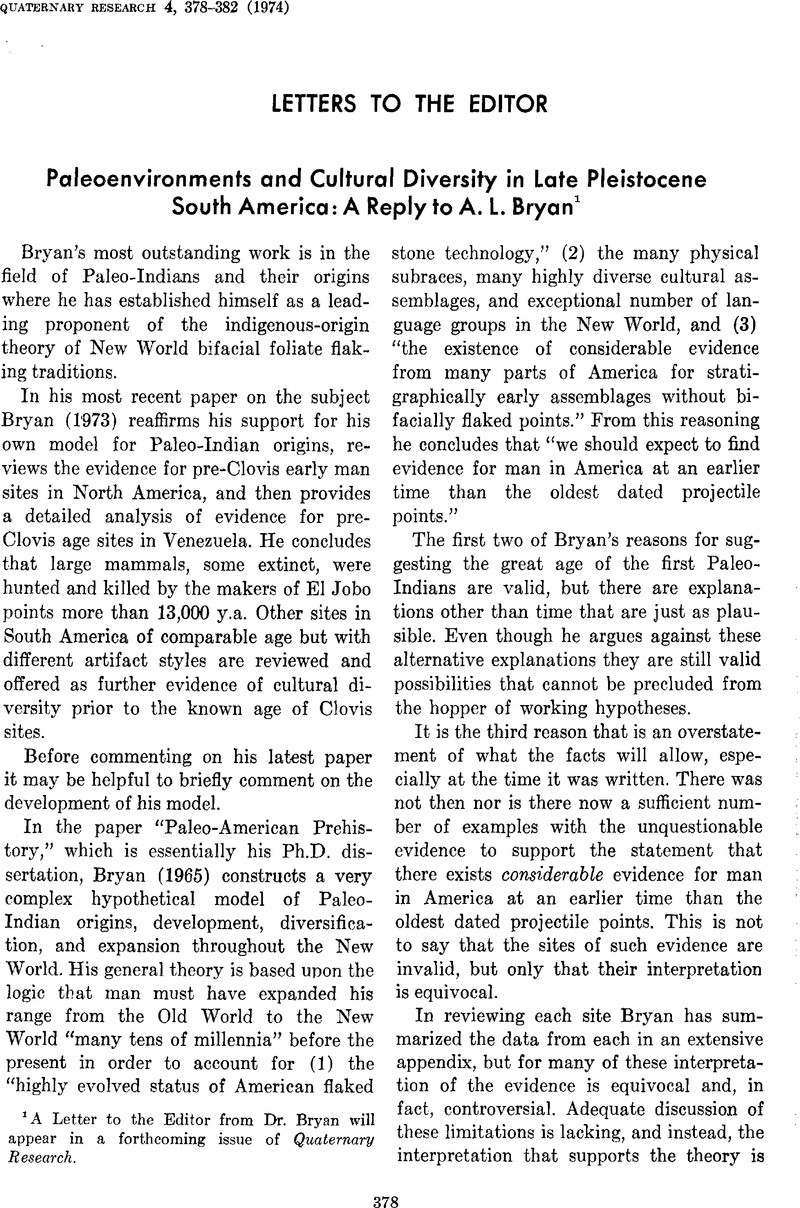Crossref Citations
This article has been cited by the following publications. This list is generated based on data provided by Crossref.
Bryan, Alan L.
1975.
Paleoenvironments and Cultural Diversity in Late Pleistocene South America: A Rejoinder to Vance Haynes and a Reply to Thomas Lynch.
Quaternary Research,
Vol. 5,
Issue. 1,
p.
151.
Klein, Richard G.
1975.
The Relevance of Old World Archeology to the first Entry of Man into the New World.
Quaternary Research,
Vol. 5,
Issue. 3,
p.
391.
Hallam, Sylvia J.
1977.
The Relevance of Old World Archaeology to the First Entry of Man into New Worlds: Colonization Seen from the Antipodes.
Quaternary Research,
Vol. 8,
Issue. 1,
p.
128.
Bryan, Alan L.
Casamiquela, Rodolfo M.
Cruxent, José M.
Gruhn, Ruth
and
Ochsenius, Claudio
1978.
An El Jobo Mastodon Kill at Taima-taima, Venezuela.
Science,
Vol. 200,
Issue. 4347,
p.
1275.
1979.
The Equatorial Rain Forest.
p.
141.
Gruhn, Ruth
and
Bryan, Alan L.
1981.
A Response to McGuire's Cautionary Tale about the Association of Man and Extinct Fauna in Great Basin Cave Sites.
Quaternary Research,
Vol. 16,
Issue. 1,
p.
117.
McGuire, Kelly R.
1982.
Reply to Gruhn and Bryan's Comments on “Cave Sites, Faunal Analysis, and Big-Game Hunters of the Great Basin: A Caution”.
Quaternary Research,
Vol. 18,
Issue. 2,
p.
240.
Smith, R.T.
1982.
Quaternary environmental change in equatorial regions with particular reference to vegetation history: A bibliography.
Palaeogeography, Palaeoclimatology, Palaeoecology,
Vol. 39,
Issue. 3-4,
p.
331.
Shipman, Pat
and
Rose, Jennie
1983.
Early hominid hunting, butchering, and carcass-processing behaviors: Approaches to the fossil record.
Journal of Anthropological Archaeology,
Vol. 2,
Issue. 1,
p.
57.
Graham, Alan
1986.
Literature on vegetational history in Latin America. Supplement III.
Review of Palaeobotany and Palynology,
Vol. 48,
Issue. 1-3,
p.
199.
Lynch, Thomas F.
1990.
Glacial-Age Man in South America? A Critical Review.
American Antiquity,
Vol. 55,
Issue. 1,
p.
12.
Gruhn, Ruth
and
Bryan, Alan L.
1991.
A Review of Lynch's Descriptions of South American Pleistocene Sites.
American Antiquity,
Vol. 56,
Issue. 2,
p.
342.
Fiedel, Stuart J.
2000.
The Peopling of the New World: Present Evidence, New Theories, and Future Directions.
Journal of Archaeological Research,
Vol. 8,
Issue. 1,
p.
39.
Fiedel, Stuart J
2002.
Initial Human Colonization of the Americas: An Overview of the Issues and the Evidence.
Radiocarbon,
Vol. 44,
Issue. 2,
p.
407.
Miotti, Laura L.
2003.
Patagonia: a paradox for building images of the first Americans during the Pleistocene/Holocene Transition.
Quaternary International,
Vol. 109-110,
Issue. ,
p.
147.
Miotti, Laura
2022.
Archaeology of Piedra Museo Locality.
p.
1.



